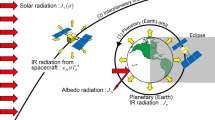Abstract
A solar magnetic sailing spacecraft utilizes the interaction between solar wind and magnetic field that is generated by a loop of superconducting wire attached onboard of the spacecraft. The development of the working principle of solar magnetic sailing from MagSail to magnetospheric plasma propulsion and magneto-plasma-sail is reviewed and discussed to study their performance, focusing on its operation for interplanetary travel. The orbital dynamic of MagSail is elaborated to explore the probable trajectories of interest for space travel. Examples for MagSail interplanetary travel are discussed for insight and future continuing work.

(adapted from [19])




(adapted from Slough [37])



(adapted from Ashida et al. [35])


Similar content being viewed by others
Abbreviations
- B :
-
Magnetic field vector (T)
- c :
-
Light speed (3 × 108 m/s)
- C d :
-
Drag coefficient
- δ :
-
Ion mean free path (m)
- E :
-
Electric field vector (V/m)
- e :
-
Elementary charge (1.6 × 10−19 C)
- I coil :
-
Coil current (A)
- I plasma :
-
Plasma current (A)
- I sp :
-
Specific impulse (s)
- J :
-
Current density (A/m2)
- L :
-
Magnetospheric size (m)
- m i :
-
Ion mass (kg)
- m e :
-
Electron mass (kg)
- M :
-
Magnetic moment (T m3)
- μ 0 :
-
Magnetic permeability (1.26 × 10−6 H/m)
- N :
-
Solar wind density (m−3)
- r iL :
-
Ion Larmor radius at magnetopause (m)
- r eL :
-
Electron Larmor radius at magnetopause (m)
- R coil :
-
Coil radius (m)
- R plasma :
-
Plasma current radius (m)
- T :
-
Plasma temperature (K)
- V :
-
Solar wind velocity (m/s)
- v :
-
Particle velocity (m/s)
- A :
-
Sail area
- α :
-
Sail pitch angle
- δ :
-
Sail clock angle
- r :
-
Spacecraft’s radial distance to Sun
- G :
-
Newton’s gravitational constant
- M ⊕ :
-
Mass of the Sun
- μ :
-
Solar gravitational constant
- m:
-
Spacecraft’s mass
- \( \hat{r} \) :
-
Spacecraft radial component
- \( \hat{\theta } \) :
-
Spacecraft transverse component
- \( \hat{\phi } \) :
-
Spacecraft normal component
- γ :
-
Spacecraft angle
- v θ :
-
Transverse component of solar sail velocity
- t − t 0 :
-
Transfer time
- r 0 :
-
Initial distance from Sun
References
Andrews DG, Zubrin RM (1990) Magnetic sails and interstellar travel. J Br Interplanet Soc 43:265–272 (ISSN 0007-084X)
Andrews DG, Zubrin RM (1990) Magnetic sailing and interstellar travel, Bangalore, India. J Br Interplanet Soc. In: 39th congress of international astronautical federation, vol 6
Zubrin RM, Andrews DG (1991) Magnetic sails and interplanetary travel. J Spacecr Rockets 28(2):197–203
Zubrin RM (1993) The use of magnetic sails to escape from low earth orbit. J Br Interplanet Soc 46(1):3–10
Zubrin RM, Martin A (2000) The magnetic sail. Final report to the NASA Institute of Advanced Concepts (NIAC), January 7. http://www.niac.usra.edu_files_studies_final_report_320Zubrin. Accessed 15 Jan 2016
Winglee RM, Slough J, Ziemba T, Goodson A (2000) Mini-magnetospheric plasma propulsion: tapping the energy of the solar wind for spacecraft propulsion. J Geophys Res 105(21):21067–21078 (ISSN 0148-0227)
Winglee RM, Ziemba T, Slough J, Euripides P, Gallagher D (2001,) Laboratory testing of the mini-magnetospheric plasma propulsion (M2P2) prototype. In: El-Genk MS (ed) CP552, space technology and applications international forum-2001
Funaki I, Yamakawa H (2009) Research status of sail propulsion using the solar wind. J Plasma Fusion Res Ser 8:1580–1584
Funaki I, Kojima H, Yamakawa H, Nakayama Y, Shimizu Y (2007) Laboratory experiment of plasma flow around magnetic sail. Astrophys Space Sci 307(1–3):63–68 (ISSN 0004-640X)
Funaki I, Kimura T, Ueno K, Ayabe T, Horisawa H, Yamakawa H, Kajimura Y, Nakashima H (2007) Laboratory experiment of magnetoplasma sail, part 2, IEPC-2007-94
Funaki I, Yamakawa H (2009) Solar wind sails. http://cdn.intechopen.com/pdfs/32547/InTech-Solar_wind_sails.pdf. Accessed 15 Jan 2014
Funaki IH, Kajimura Y, Ueno K, Oshio Y, Nishida H, Usui H, Matsumota M, Shinohara I (2010) Experimental and numerical investigations on the thrust. In: AIAA-2010-6773
Domonkos MT, Patterson MJ, Jankovsky RS (2002) Glenn Research Center, Cleveland, Ohio, Ion Engine and Hall Thruster Development at the NASA Glenn Research Center, NASA/TM—2002-211969
Vulpetti G (1994) A critical review on the viability of a space propulsion based on the solar wind momentum flux. Acta Astronaut 32(9):641–644
Yamakawa H (2003) A guidance strategy for the radially accelerated trajectory. In: AAS paper 03–521, AAS/AIAA in astrodynamics specialists conference, Big Sky, Montana, August 3–7
Ashida Y, Yamakawa H, Funaki I, Usui H, Kajimura Y, Kojima H (2014) Thrust evaluation of small-scale magnetic sail spacecraft by 3D particle-in-cell simulation, Kyoto U, 1.B35026. http://repository.kulib.kyoto-u.ac.jp/dspace/bitstream/2433/182204/1/1.B35026.pdf. Accessed 15 Jan 2016
Richardson D, Schwadron NA The limits of our solar system. ftp://space.mit.edu/pub/plasma/publications/jdr_schwadron_book/jdr_schwadron_book.pdf. Accessed 7 June 2017
Zurbuchen TH, von Steiger R, Manchester WB, Fisk LA (2014) Heliospheric magnetic field configuration at solar maximum conditions: consequences for galactic cosmic rays, CP719, physics of the outer heliosphere: third international IGPP conference. American Institute of Physics
Anonymous (1997) The sun and heliosphere in three dimensions. https://umbra.nascom.nasa.gov/SEC/STEREO_sdt_report.pdf. Accessed 1 May 2018
Anonymous, Solar Wind: Global Properties ENCYCLOPEDIA OF ASTRONOMY AND ASTROPHYSICS, Copyright © Nature Publishing Group 2001 Brunel Road, Houndmills, Basingstoke, Hampshire, RG21 6XS, UK Registered No. 785998 and Institute of Physics Publishing 2001 Dirac House, Temple Back, Bristol, BS1 6BE, UK 1
Parker EN (1965) Dynamical theory of the solar wind. Space Sci Rev 4:666–708
Solar Probe (1989) Scientific rationale and mission concept. JPL D-6797 (1989)
Meyer-Vernet N (1999) How does the solar wind blow? A simple kinetic model. Eur J Phys 20:167–176
Matsumoto M, Usui H, Nunami M, Nakamura M, Shinohara I (2013) Two-dimentional AMR-PIC plasma simulation for mini-magnetosphere of magnetized object. Plasma Fusion Res 8:2406132
Maksimovic M, Zouganelis I, Chaufray J-Y et al (2005) Radial evolution of the electron distribution functions in the fast solar wind between 0.3 and 1.5 AU. J Geophys Res Atmos 110:A09104. https://doi.org/10.1029/2005JA011119
Cattell C, Catto P, Funsten H, Garnier D, Hershkowitz N, Myers R, Petschekand H, Winske R (2005) Physics and technology of the feasibility of plasma sails, PSFC/JA-05-26. J Geophys Res.
Gros C (2017) Universal scaling relation for magnetic sails: momentum braking in the limit of dilute interstellar media. arXiv:1707.02801v2 [physics.space-ph]. Accessed 8 Nov 2017. https://arxiv.org/pdf/1707.02801.pdf. Accessed 15 Apr 2018
Russel CT (2018) Solar wind and interplanetary magnetic field: a tutorial. https://agupubs.onlinelibrary.wiley.com/doi/pdf. https://doi.org/10.1029/gm125p0073. Accessed 15 Apr 2018
Khazanov G, Delamere P, Kabin K, Linde TL (2005) Fundamentals of the plasma sail concept: magnetohydrodynamic and kinetic studie. J Propul Power 21(5):853–864
Funaki I (2018) Overview of sail propulsion for space flight, 2015-lecture. http://www.al.t.u-tokyo.ac.jp/lecture/Chap8(SailingPropulsion).pdf. Accessed 15 Apr 2018
Ashida Y (2014) Study on propulsive characteristics of magnetic sail and magneto plasma sail by plasma particle simulations. Doctoral thesis, Kyoto University
Funaki I, Kajimura Y, Nishida H, Arita H, Ashida Y, Yamanaka H, Oshio Y, Ueno K, Yamamura H, Yamagiwa Y (2013) Magnetoplasma Sail with equatorial ring-current. In: AIAA 2013-3878, 49th AIAAASME/SAE/ASEE joint propulsion conference and exhibit, San Jose, July 2013
Nagasaki Y, Funaki I, Nakamura T, Yamakawa H (2015) Increase in thrust of magneto plasma sail using solid or deployable superconducting coil. In: 34th international electric propulsion conference, IEPC-2015-328, Kobe, July 6–10, 2015
Yamakawa H, Funaki I, Nakayama Y, Fujita K, Ogawa H, Nonaka S, Kuninaka H, Sawai S, Nishida H, Asahi R, Otsu H, Nakashima H (2006) Magneto-plasma sail. An engineering satellite concept and its application for outer planet missions. Acta Astronaut 59(8–11):777–784
Ashida Y, Funaki I, Yamakawa K (2011) Two-dimensional particle-in-cell simulation of magnetic sails. In: IEPC-2011-180, Presented at the 32nd international electric propulsion conference, Wiesbaden, Germany, 11–15 September 2011
Nishida H, Funaki I, Ogawa H, Inatani Y MHD analysis on propulsive characteristics of magneto plasma sail IEPC-2007-195. http://erps.spacegrant.org/uploads/images/images/iepc_articledownload_1988-2007/2007index/IEPC-2007-195.pdf. Accessed 24 Jan 2017
Slough J (2003) The plasma magnet. NASA Institute of Advanced Concepts, Mountain View
Scott DE (2013,) A note on the acceleration of the solar wind. https://electric-cosmos.org/SolarWind.pdf. Accessed 15 Jan 2017
Kasper JC (2002) Solar wind plasma—kinetic properties and micro-instabilities. Ph.D., MIT
Schield MA (1969) Pressure balance between solar wind and magnetosphere. J Geophys Res Space Phys 74:1275–1286
Kare JT (2002) High-acceleration micro-scale laser sails for interstellar propulsion. NASA NIAC Research Center. www.niac.usra.edu/files/studies/final_report/597Kare.pdf. Accessed 15 Jan 2017
Fujita K (2004) Particle simulation of moderately-sized magnetic sails. J Space Technol Sci 20(2):26–31 (ISSN 0911-551X)
Djojodihardjo H, Aziz N (2015) An exploratory study of magnetic sailing. In: 6th CSA-IAA conference on advanced space technology, 10–12 Nov 2015, Shanghai, China
Djojodihardjo H, Aziz N (2016) Solar magnetic sailing configuration and inter-planetary travel—an exploratory study. In: Paper IAC-16.C4.8.9. Presented at the, 67th international astronautical congress
McInnes C (1999) Solar sailing: technology, dynamics, and mission applications. Springer-Praxis, Chichester
McInnes CR (2003) Orbits in a generalized two-body problem. J Guidance Control Dyn 26(5):743–749 (ISSN 0731-5090)
Alfriend KT, Vadali SR, Gurfil P, How JP, Breger LS (2010) Spacecraft formation flying. Butterworth-Heinemann, Burlington
Author information
Authors and Affiliations
Corresponding author
Rights and permissions
About this article
Cite this article
Djojodihardjo, H. Review of Solar Magnetic Sailing Configurations for Space Travel. Adv. Astronaut. Sci. Technol. 1, 207–219 (2018). https://doi.org/10.1007/s42423-018-0022-4
Received:
Revised:
Accepted:
Published:
Issue Date:
DOI: https://doi.org/10.1007/s42423-018-0022-4





